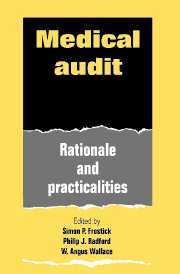Book contents
- Frontmatter
- Contents
- List of contributors
- Foreword
- Foreword
- 1 Introduction
- 2 Audit: historical and future perspectives
- 3 Audit philosophy
- 4 Medical audit: a view from the centre
- 5 Audit: a view from the Royal College of Surgeons of England
- 6 The regional viewpoint
- 7 Medical audit: the needs of the District Health Authorities
- 8 Resource management and budget holding
- 9 Unit and district information systems
- 10 Read codes and medical audit
- 11 Data capture direct from doctors
- 12 Computer systems: practice, limitations and pitfalls
- 13 Paediatric audit
- 14 Audit in obstetrics and gynaecology
- 15 Audit in general surgery
- 16 Orthopaedic audit: guidelines and hints
- 17 Installing audit in general practice and general dental practice
- 18 Clinical audit in psychiatry. Models for audit in mental health
- 19 Audit in anaesthesia
- 20 Audit in intensive care
- 21 Medical audit: lessons from the USA
- 22 Quality control in health care: the Dutch experience
- 23 Medical audit: experience from Sweden
- 24 Performance indicators
- 25 Measuring outcome and quality control
- 26 Audit: will it work?
- 27 What has been achieved so far?
- 28 A practical guide to audit
- Index
20 - Audit in intensive care
Published online by Cambridge University Press: 30 September 2009
- Frontmatter
- Contents
- List of contributors
- Foreword
- Foreword
- 1 Introduction
- 2 Audit: historical and future perspectives
- 3 Audit philosophy
- 4 Medical audit: a view from the centre
- 5 Audit: a view from the Royal College of Surgeons of England
- 6 The regional viewpoint
- 7 Medical audit: the needs of the District Health Authorities
- 8 Resource management and budget holding
- 9 Unit and district information systems
- 10 Read codes and medical audit
- 11 Data capture direct from doctors
- 12 Computer systems: practice, limitations and pitfalls
- 13 Paediatric audit
- 14 Audit in obstetrics and gynaecology
- 15 Audit in general surgery
- 16 Orthopaedic audit: guidelines and hints
- 17 Installing audit in general practice and general dental practice
- 18 Clinical audit in psychiatry. Models for audit in mental health
- 19 Audit in anaesthesia
- 20 Audit in intensive care
- 21 Medical audit: lessons from the USA
- 22 Quality control in health care: the Dutch experience
- 23 Medical audit: experience from Sweden
- 24 Performance indicators
- 25 Measuring outcome and quality control
- 26 Audit: will it work?
- 27 What has been achieved so far?
- 28 A practical guide to audit
- Index
Summary
This review will examine audit in intensive care (systems of quality assurance), and audit of intensive care (what intensive care has achieved). An approach to intensive care audit, and the framework of the review, is given in Figure 20.1. It may be helpful to start by defining the main terms used in this chapter.
Key definitions
Intensive care is a multi-disciplinary specialty providing a comprehensive diagnostic and therapeutic service for patients with acute failure of two or more organ-systems, or with isolated acute respiratory failure. Patients with single organ-system failures may also require intensive care if their condition is unstable. A minimum 1:1 nurse:patient ratio is required, in intensive care units (ICUs) together with continuous cover by consultants and resident junior doctors.
High dependency units (HDUs) are intended to care for patients with acute failure of not more than one organ-system, excluding acute failure of the respiratory system. HDUs are not suitable places for caring for patients requiring mechanical ventilation or complex organ-system support. They have an important prophylactic role in preventing organ-system dysfunction and in treating postoperative pain following major surgery. Specialist HDUs such as coronary care, renal medicine and transplant units are often best sited within the relevant specialist clinical area, but general service HDUs (for hospital-wide work) should be placed close to the ICU in order to ensure fair access to all clinical services, and to make efficient use of existing medical management and nursing expertise.
- Type
- Chapter
- Information
- Medical Audit , pp. 307 - 338Publisher: Cambridge University PressPrint publication year: 1993

